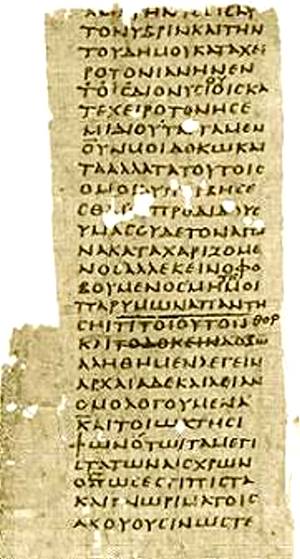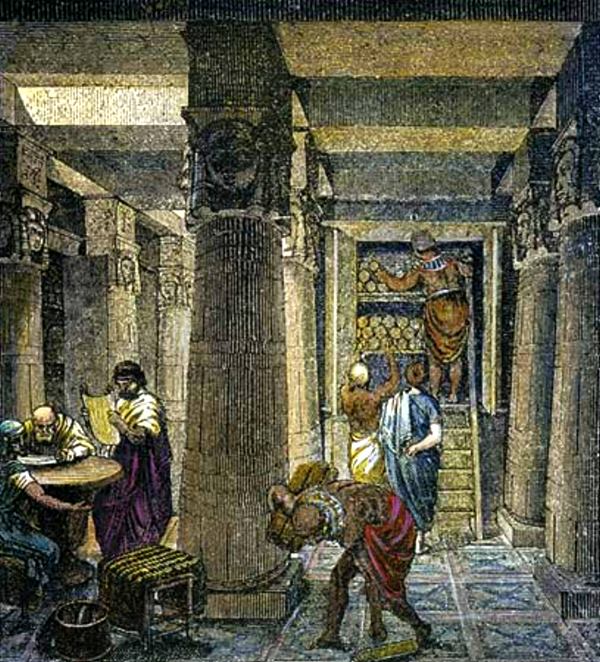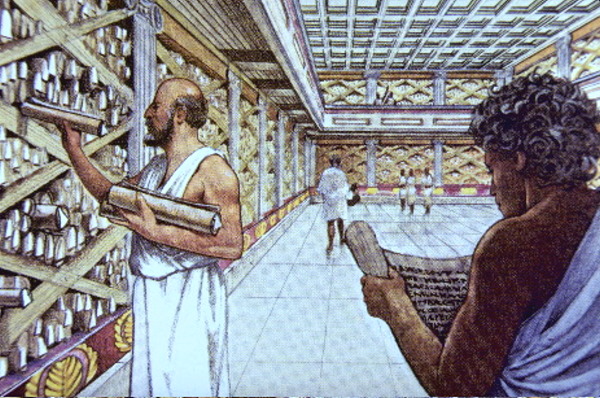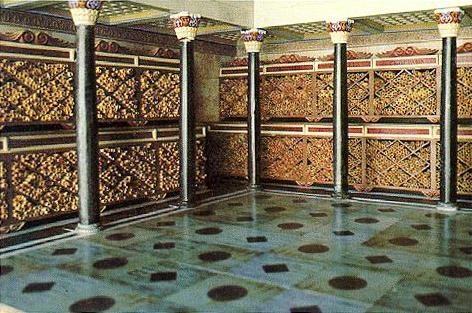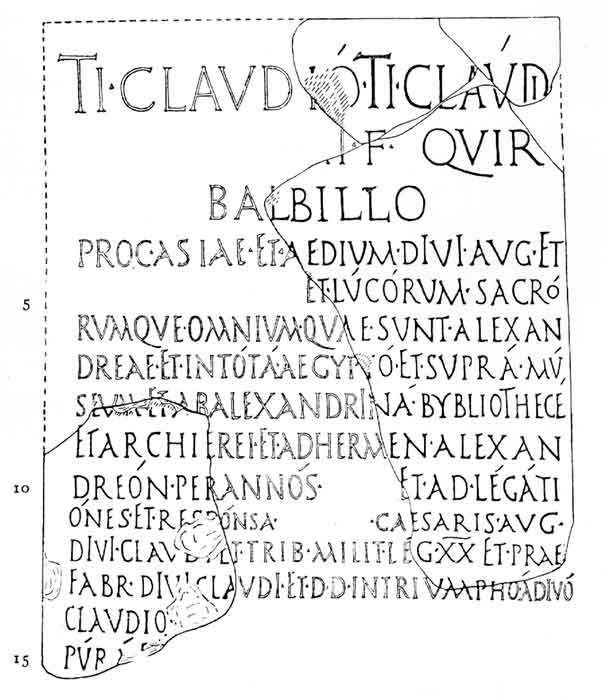|
Alexandria's Famous Library ...
"Against Ctesiphon" |
||||
|
..
Digital rendition of The Library
of Alexandria. The library housed a wealth of
knowledge.
The Library of Alexandria was one of the best-known of the libraries of the ancient world. One of the interesting facts about the ancient world that seems to be missing from many history books is that there were many great collections of books and literature in ancient times and most were open to any scholar from anywhere in the world. The library at Alexandria actually competed with that at Pergamum in amassing the most complete collection of books in the world. This went on in the 200's B. C., and it is interesting to note that there were already so many works in existence that obtaining a copy of each would have been an impossible undertaking even then. The destruction of this priceless treasure was a stroke of the most unimaginable bad luck. If Byzantine Egypt had been taken by one of the later Islamic conquerors, this irreplaceable collection would have been counted amongst the finest of the spoils of war to fall into a victor's hands. Early in the year A. D. 642, Alexandria surrendered to Amrou, the Islamic general leading the armies of Omar, Caliph of Baghdad. Long one of the most important cities of the ancient world and capital of Byzantine Egypt, Alexandria surrendered only after a long siege and attempts to rescue the city by the Byzantines. On the orders of Omar, Caliph of Baghdad, the entire collection of books (except for the works of Aristotle) stored at the Library of Alexandria were removed and used as fuel to heat water for the city's public baths. This is not the first time the library was damaged or destroyed. Originally built to house the massive collection of books accumulated by the Ptolemaic rulers of Egypt, the library had been devastated by fire several times. During Julius Caesar's Alexandrian campaign in 47 B. C., Caesar set fire to ships in the port. The fire spread to the library, which was called the Museum at that time. In A. D. 391, riots instigated by fanatical Christians damaged the collection heavily. During the years between disastrous events, the library collection had been gradually restored. In 641, the Caliph of Baghdad exhibited the same spirit of religious fanaticism in ordering Amrou to burn the books stored there. The loss of the library at Alexandria was a particularly grievous blow because the works of so many Roman scholars. literary geniuses, and historians were destroyed. Source: San Jose State University |
||||
|
....
A 19th-century German engraving depicting a hall in the ancient Library of Alexandria German engraving The Burning of
the Library of
Alexandria
The loss of the ancient world's single greatest archive of knowledge, the Library of Alexandria, has been lamented for ages. But how and why it was lost is still a mystery. The mystery exists not for lack of suspects but from an excess of them. Alexandria was Ptolemy'sfounded in Egypt by Alexander the Great. His successor as Pharaoh, Ptolomy II Soter, founded the Museum or Royal Library of Alexandria in 283 BC. The Museum was a shrine of the Muses modeled after the Lyceum of Aristotle in Athens. The Museum was a place of study which included lecture areas, gardens, a zoo, and shrines for each of the nine muses as well as the Library itself. It has been estimated that at one time the Library of Alexandria held over half a million documents from Assyria, Greece, Persia, Egypt, India and many other nations. Over 100 scholars lived at the Museum full time to perform research, write, lecture or translate and copy documents. The library was so large it actually had another branch or "daughter" library at the Temple of Serapis. The first person blamed for the destruction of the Library is none other than Julius Caesar himself. In 48 BC, Caesar was pursuing Pompey into Egypt when he was suddenly cut off by an Egyptian fleet at Alexandria. Greatly outnumbered and in enemy territory, Caesar ordered the ships in the harbor to be set on fire. The fire spread and destroyed the Egyptian fleet. Unfortunately, it also burned down part of the city - the area where the great Library stood. Caesar wrote of starting the fire in the harbor but neglected to mention the burning of the Library. Such an omission proves little since he was not in the habit of including unflattering facts while writing his own history. But Caesar was not without public detractors. If he was solely to blame for the disappearance of the Library it is very likely significant documentation on the affair would exist today. The second story of the Library's destruction is more popular, thanks primarily to Edward Gibbon's "The Decline and Fall of the Roman Empire". But the story is also a tad more complex. Theophilus was Patriarch of Alexandria from 385 to 412 AD. During his reign the Temple of Serapis was converted into a Christian Church (probably around 391 AD) and it is likely that many documents were destroyed then. The Temple of Serapis was estimated to hold about ten percent of the overall Library of Alexandria's holdings. After his death, his nephew Cyril became Patriarch. Shortly after that, riots broke out when Hierax, a Christian monk, was publicly killed by order of Orestes the city Prefect. Orestes was said to be under the influence of Hypatia, a female philosopher and daughter of the "last member of the Library of Alexandria". Although it should be noted that some count Hypatia herself as the last Head Librarian. Alexandria had long been known for it's violent and volatile politics. Christians, Jews and Pagans all lived together in the city. One ancient writer claimed that there was no people who loved a fight more than those of Alexandria. Immediately after the death of Hierax a group of Jews who had helped instigate his killing lured more Christians into the street at night by proclaiming that the Church was on fire. When the Christians rushed out the largely Jewish mob slew many of them. After this there was mass havoc as Christians retaliated against both the Jews and the Pagans - one of which was Hypatia. The story varies slightly depending upon who tells it but she was taken by the Christians, dragged through the streets and murdered. Some regard the death of Hypatia as the final destruction of the Library. Others blame Theophilus for destroying the last of the scrolls when he razed the Temple of Serapis prior to making it a Christian church. Still others have confused both incidents and blamed Theophilus for simultaneously murdering Hypatia and destroying the Library though it is obvious Theophilus died sometime prior to Hypatia. The final individual to get blamed for the destruction is the Moslem Caliph Omar. In 640 AD the Moslems took the city of Alexandria. Upon learning of "a great library containing all the knowledge of the world" the conquering general supposedly asked Caliph Omar for instructions. The Caliph has been quoted as saying of the Library's holdings, "they will either contradict the Koran, in which case they are heresy, or they will agree with it, so they are superfluous." So, allegedly, all the texts were destroyed by using them as tinder for the bathhouses of the city. Even then it was said to have taken six months to burn all the documents. But these details, from the Caliph's quote to the incredulous six months it supposedly took to burn all the books, weren't written down until 300 years after the fact. These facts condemning Omar were written by Bishop Gregory Bar Hebrĉus, a Christian who spent a great deal of time writing about Moslem atrocities without much historical documentation.
So who did burn the Library of Alexandria? Unfortunately most of the writers from Plutarch (who apparently blamed Caesar) to Edward Gibbons (a staunch atheist or deist who liked very much to blame Christians and blamed Theophilus) to Bishop Gregory (who was particularly anti-Moslem, blamed Omar) all had an axe to grind and consequently must be seen as biased. Probably everyone mentioned above had some hand in destroying some part of the Library's holdings. The collection may have ebbed and flowed as some documents were destroyed and others were added. For instance, Mark Antony was supposed to have given Cleopatra over 200,000 scrolls for the Library long after Julius Caesar is accused of burning it. It is also quite likely that even if the Museum was destroyed with the main library the outlying "daughter" library at the Temple of Serapis continued on. Many writers seem to equate the Library of Alexandria with the Library of Serapis although technically they were in two different parts of the city. The real tragedy of course is not the uncertainty of knowing who to blame for the Library's destruction but that so much of ancient history, literature and learning was lost forever. Selected Sources:
|
||||
|
....
The wall portraits show Alexander the Great (left) and Serapis (right). The Royal Library of Alexandria in Alexandria, Egypt was once the largest library in the world. It is generally assumed to have been founded at the beginning of the 3rd century BC, during the reign of Ptolemy II of Egypt, after Ptolemy's father had raised what would become the first part of the library complex, the temple of the Muses - the Musaeum (which is the source of the word "museum"). At its peak, the Royal Library is believed to have held about half of a million books and was initially organized by Demetrius Phalereus. It has been reasonably established that the library was destroyed by fire, but to this day the details of the destruction (or destructions) remain a lively source of controversy. The loss of the library is widely considered a great loss to humanity. It contained the compiled history of generations, not just of Egypt. The five hundred thousand or so volumes were not codices but scrolls, made of papyrus and written by hand. Scientists and learned men of the time would visit the library from all over to study, and add to the great collection. It is said that Archimedes once visited Alexandria, studying for hours in the library and museum. Often, scientists would re-write old scrolls that were badly written or growing brittle with age. The Bibliotheca Alexandrina was inaugurated in 2003 near the site of the old library . One story holds that the Library was seeded with Aristotle's own private collection, through one of his students, Demetrius Phalereus. Another story concerns how its collection grew so large: By decree of Ptolemy III of Egypt, all visitors to the city were required to surrender all books and scrolls in their possession; these writings were then swiftly copied by official scribes. The originals were put into the Library, and the copies were delivered to the previous owners. While encroaching on the rights of the traveler or merchant, the process also helped to create a reservoir of books in the relatively new city. The Library's contents were likely distributed over several buildings, with the main library either located directly attached to or close to the oldest building, the Museum, and a daughter library in the younger Serapeum, also a temple dedicated to the god Serapis. In 2004 a Polish-Egyptian team claimed to have discovered a part of the library while excavating in the Bruchion region. The archaeologists claimed to have found thirteen "lecture halls", each with a central podium. Zahi Hawass, president of Egypt's Supreme Council of Antiquities said that all together, the rooms uncovered so far could have seated 5000 students.
The Destruction In 391, Emperor Theodosius I ordered the destruction of all pagan temples, and Patriarch Theophilus of Alexandria complied with this request. Socrates Scholasticus provides the following account of the destruction of the temples in Alexandria in the fifth book of his Historia Ecclesiastica: "At the solicitation of Theophilus bishop of Alexandria the emperor issued an order at this time for the demolition of the heathen temples in that city; commanding also that it should be put in execution under the direction of Theophilus. Seizing this opportunity, Theophilus exerted himself to the utmost to expose the pagan mysteries to contempt. And to begin with, he caused the Mithreum to be cleaned out, and exhibited to public view the tokens of its bloody mysteries. Then he destroyed the Serapeum, and the bloody rites of the Mithreum he publicly caricatured; the Serapeum also he showed full of extravagant superstitions, and he had the phalli of Priapus carried through the midst of the forum. Thus this disturbance having been terminated, the governor of Alexandria, and the commander-in-chief of the troops in Egypt, assisted Theophilus in demolishing the heathen temples. These were therefore razed to the ground, and the images of their gods molten into pots and other convenient utensils for the use of the Alexandrian church; for the emperor had instructed Theophilus to distribute them for the relief of the poor. All the images were accordingly broken to pieces, except one statue of the god before mentioned, which Theophilus preserved and set up in a public place; 'Lest,' said he, 'at a future time the heathens should deny that they had ever worshiped such gods.'"
(source: Christopher Haas: Alexandria in late antiquity, Baltimore 1997) The Serapeum housed part of the Library, but it is not known how many books were contained in it at the time of destruction. Notably, Paulus Orosius admitted in the sixth book of his History against the pagans: "[T]oday there exist in temples book chests which we ourselves have seen, and, when these temples were plundered, these, we are told, were emptied by our own men in our time, which, indeed, is a true statement." Some or all of the books may have been taken, but any books left in the Serapeum at the time would have been destroyed when it was razed to the ground. As for the Museum, Mostafa El-Abbadi writes in Life and Fate of the ancient Library of Alexandria (Paris 1992): "The Mouseion, being at the same time a 'shrine of the Muses', enjoyed a degree of sanctity as long as other pagan temples remained unmolested. Synesius of Cyrene, who studied under Hypatia at the end of the fourth century, saw the Mouseion and described the images of the philosophers in it. We have no later reference to its existence in the fifth century. As Theon, the distinguished mathematician and father of Hypatia, herself a renowned scholar, was the last recorded scholar-member (c. 380), it is likely that the Mouseion did not long survive the promulgation of Theodosius' decree in 391 to destroy all pagan temples in the City."
Plutarch blamed Julius Caesar for the burning of the Library, whereas Edward Gibbon blamed Theophilus. According to Ibn al-Kifti's (History of the wise), whose story was repeated by Bishop Gregory Bar Hebraeus, the remaining books were destroyed by general Amrouh following orders of Caliph Umar (see Luciano Canfora "The vanished Library"). The collection may have ebbed and flowed as some documents were destroyed and others were added. For instance, Mark Antony was supposed to have given Cleopatra over 200,000 scrolls for the Library long after Julius Caesar is accused of burning it. It is also quite likely that even if the Museum was destroyed with the main library the outlying "daughter" library at the Temple of Serapis continued on. Many writers seem to equate the Library of Alexandria with the Library of Serapis although technically they were in two different parts of the city. The tragedy of course is not the uncertainty of knowing who to blame for the Library's destruction but that so much of ancient history, literature and learning was lost forever. References:
|
||||
| FAIR USE NOTICE: This page contains copyrighted material the use of which has not been specifically authorized by the copyright owner. Pegasus Research Consortium distributes this material without profit to those who have expressed a prior interest in receiving the included information for research and educational purposes. We believe this constitutes a fair use of any such copyrighted material as provided for in 17 U.S.C § 107. If you wish to use copyrighted material from this site for purposes of your own that go beyond fair use, you must obtain permission from the copyright owner. | ||||
|
|
